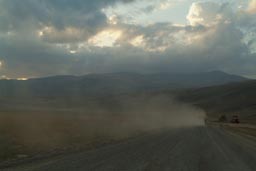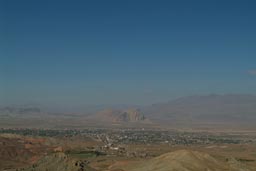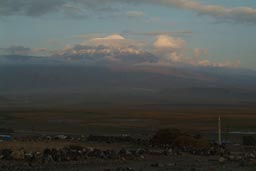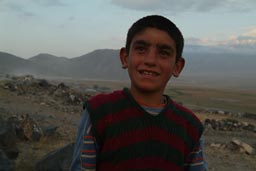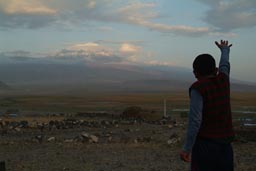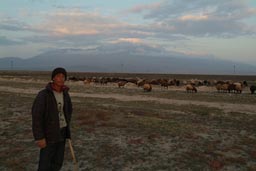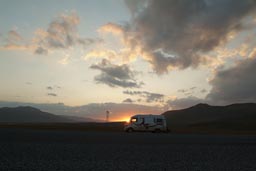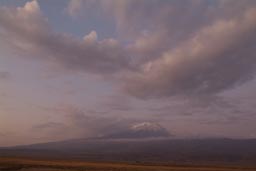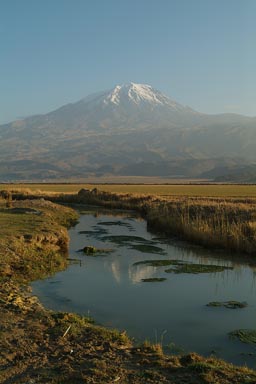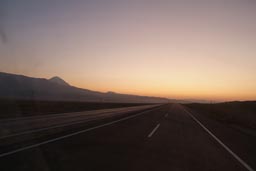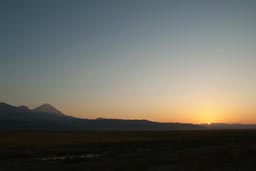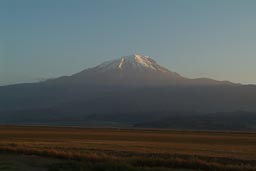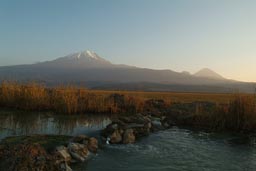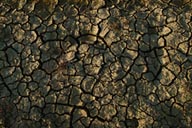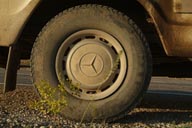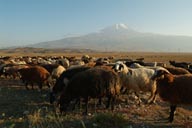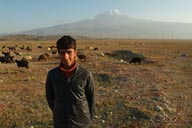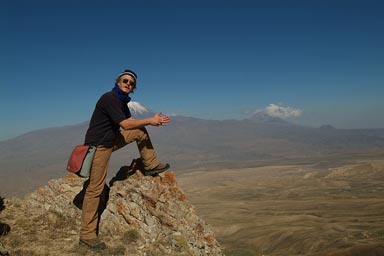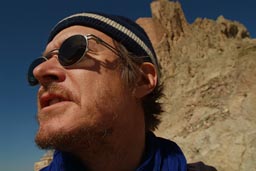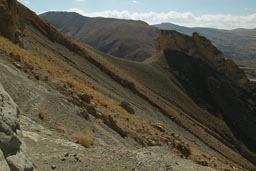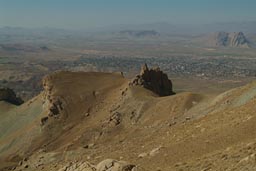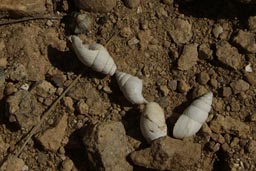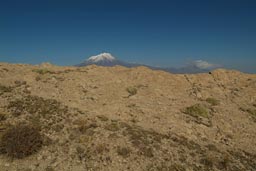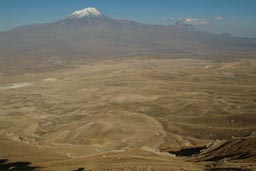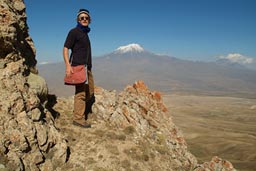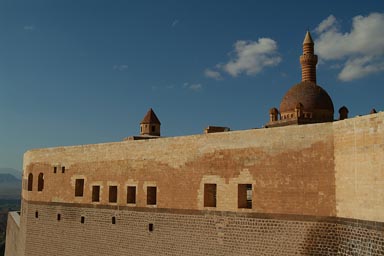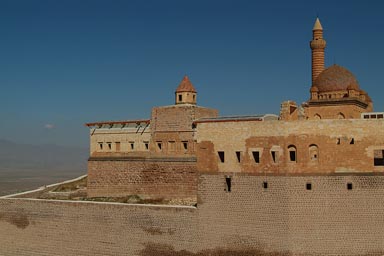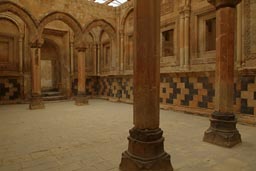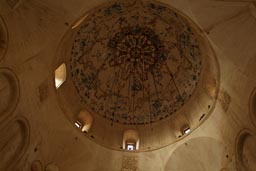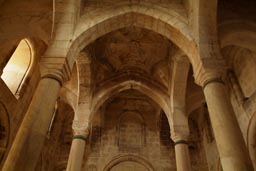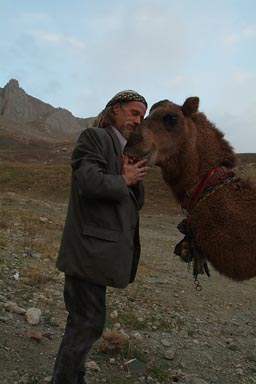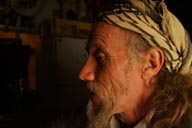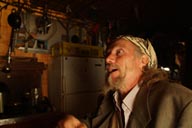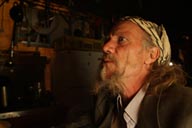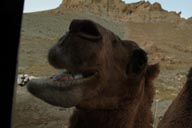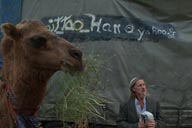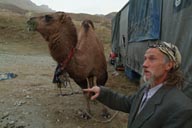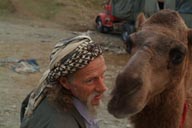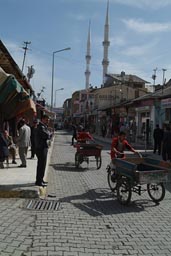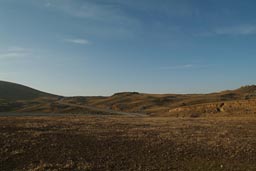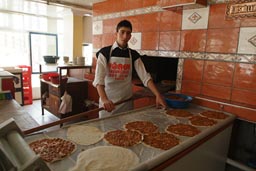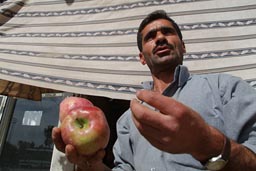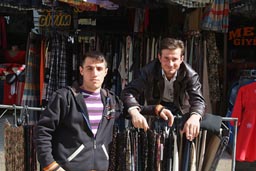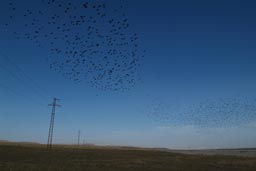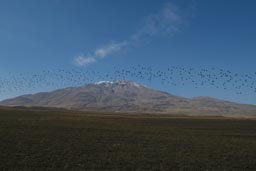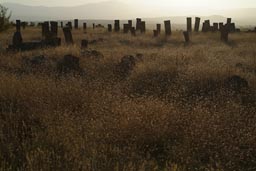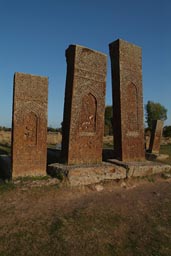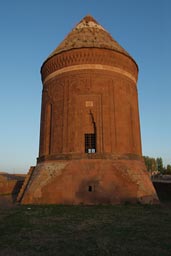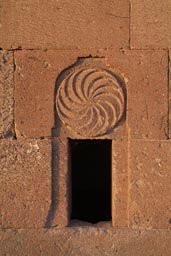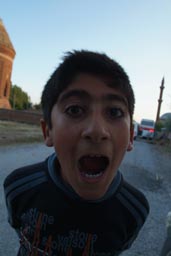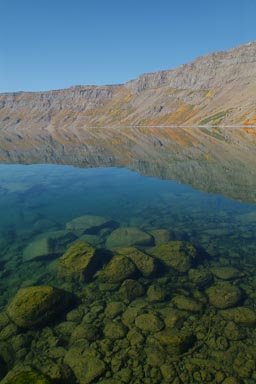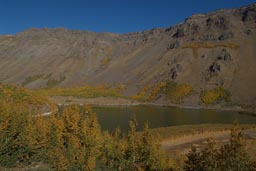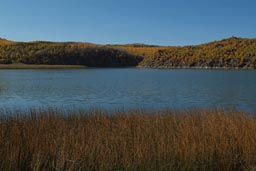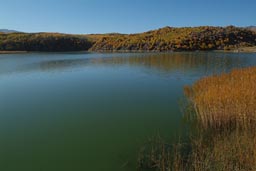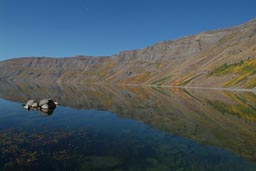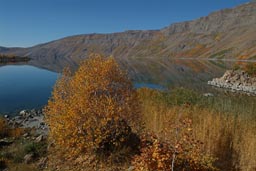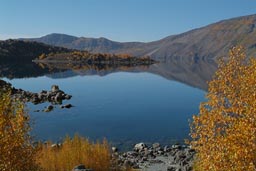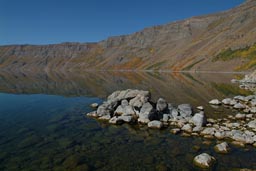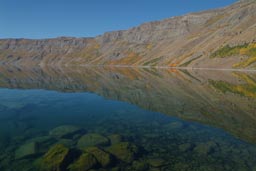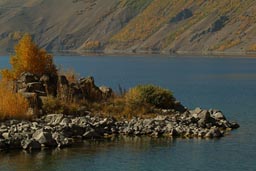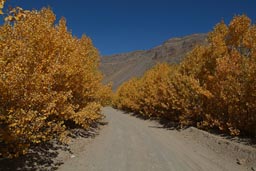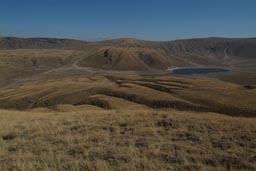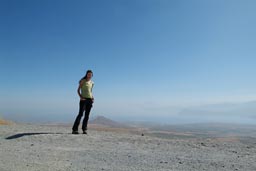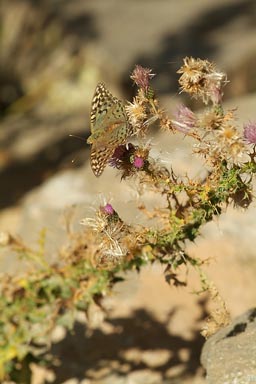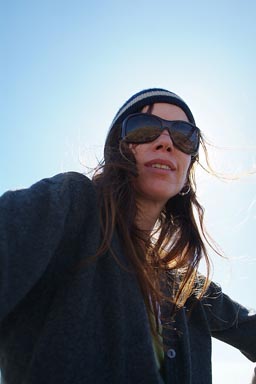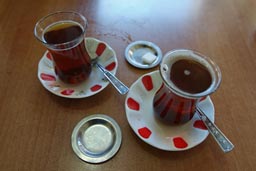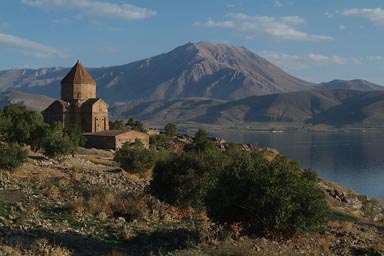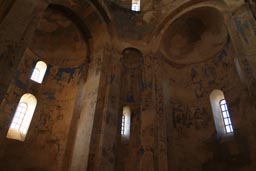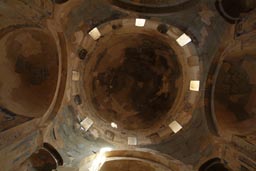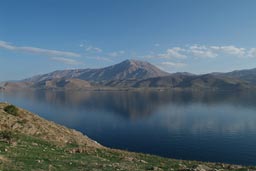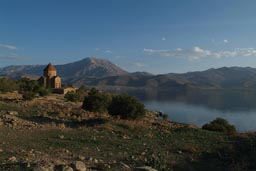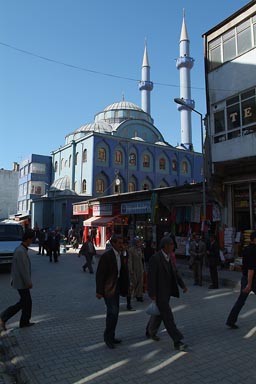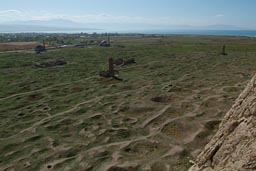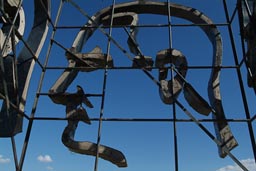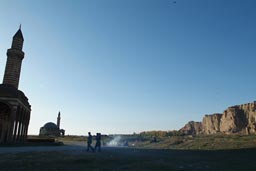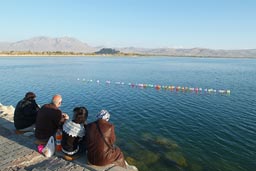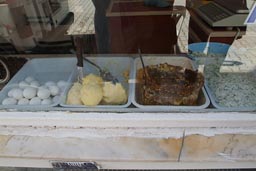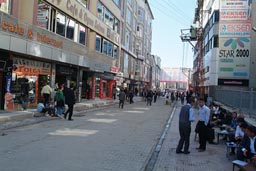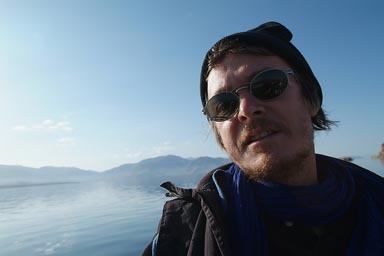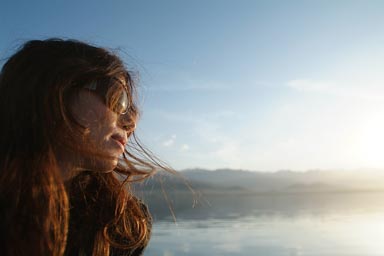www.thisfabtrek.com > journey > asia > turkey > 20091017-van
Turkey the East.
Download GPS (KML) track/waypoints.
From Kars to Ani, to Kars, this is Turkey the East, a conglomerate of cultures, before Armenian, Turkish, Kurdish; since long just Turkish and Kurdish and the further south I get just Kurdish! Back from the border, the Armenian closed border, hard to grasp/guess from the stones and rubble the former importance of Armenian culture/craftsmanship/intelligence to this region and the overall Turkey/formerly Ottoman empire.
South from Kars towards another border, the one with Iran, in Doğubeyazıt the “real East” commences, the “true Asia”, true and false. But Turkey is such, at crossroads in many respects, between past and present, East and West, North and South, Christianity and Islam, backwardness and modernity or civilised and archaic, Atatürk’s prime concern, also secularity and faith led.
Desert starts here, no more free water comes out of mountain ridges at every bend of the road; and we have not south so very much.
Kars maybe is the frontier, the last what we could call liberal, open, the young small smart rebel in the outer East of Turkey, with Atatürk on mind, so at least is my perception and I will be surprised, but to this later. First Doğubeyazıt, some mistrust of elderly, the clocks evidently tick differently, town is all chaos, a cuddle mingle of traffic, traders, children and animals. Doğubeyazıt is placed on the road to Iran, one of two border crossings, an open border for trade, an exchange for culture and contraband; Kurds live on both sides of the border, everyone’s family here and there. So it seems already like Persia, and my heart feels heavy knowing I would not go there, not just yet.
Holy Mount Ararat, Doğubeyazıt.
Doğubeyazıt is south west of Mount Ararat (wiki), just below in the plains of around 1500m. Holy Ararat the cone shaped dormant volcano mountain is with 5137m Turkey’s highest point, where gods live, no man can go, for thousands of years sacredly respected, it too makes a deep impression on me. After Genesis Noah's Ark came here to rest, "in the mountains of Ararat," but to date no scientific proven remains of the ark have ever been found. And of course won’t ever be...
But this first approach on Sunday 11th of October is a pretty hazy affair, prohibits a good full view. But Google Earth that night, on free wifi internet inside the van, shows good clear weather ahead. Re free wifi I have been lucky recently.
So what is it that wakes me at 5.30 when all still is dark and cold? The skies clear, coffee in hand I ride east towards sunrise, towards the Iranian border. Soon the first rays touch the snowy tops of Ararat. Then 6.09 or a bit later the orange ball goes up to the right of Lesser Ararat, Ararat’s shorter brother.
Somehow, looking for İshak Paşa Palace, which I find closed I decide to climb the rocky mountain on the opposite (southern) side of Ararat. No preparations, I don’t take any water, 2 hours up, no real trail, I need to find my path around the cliffs.
Not such a climb from 1900m to 2400m, but I feel the pain and the beers from the good days in Kars. After the last turn, the last boulder, the last cliff the reward is mine; suddenly there is no more between me and the skies and a sensational view on Mount Ararat and his shorter cousin and the plains below.
İshak Paşa Palace/Ishak Pasha Palace.
A day later Christina arrives! Tuesday. She has done more miles between Istanbul and Eastern Turkey than even I. Together we come back to the 1784 İshak Paşa Palace (wiki), a magnificent restored piece of architecture in a scenic setting. Ishak Paşa a probably Kurdish clan chief, war lord out here, somehow blessed with the Sultans grace, he allowed for such extravaganza out here for himself, the Sultan is 1001 miles away.
We meet Goran, the camelman.
By Christina.
Caravanning endlessly through Mongolian corridors to the marshes of Mount Ararat, is a man whose stories are longer than his journey. More resilient than a flying carpet, this man stops at nothing except the death of his camel. Goran lost one of his babies about a year ago, the old camel stallion had been a true friend for 18 years, and Goran has since been stranded here in Doğubeyazıt.
His heart still is generous and he welcomes us to his abode, an old Swiss truck from the 70s full of dust, chickens, pictures, old pots and pans, and fantastic stories. Who knows how he managed to get the semitrailer up here? He talks of the end of the world and of universal religion, of Algerian women, and Rakı. His Turkish neighbors, instruments in hand, join us for a shared moment of music and chat.
At sun down Julia, a domesticated double humped Mongolian camel, with dreamy brown eyes joins us as she sticks her huge head into the truck window to see what all the ruckus is about! Between Kazakhstan and Turkey, Goran has been looking to find a mate for Julia, but has yet to come up with one. Goran leaves to feed his faithful friend and we watch; touched by his generous spirit, and in awe of his strength and originality. He is alone this optimistic foreigner in a foreign land, yet remains a lover and a believer - in the rights of camels, of nomads, of communal property and of humanity. We drive off chasing the sun and wondering about the wild, colorful man in the mountains between Turkey and Iran hoping that his sun will soon rise.
Lake Van, Turkish/Kurdish friendliness.
So what can go better after Ararat and these days of sun on top of this world? Turkey is an enormous country, new palaces, churches and mosques, tombstones, mountains and lakes await the traveller on every corner. Furthermore people are of a friendly generosity I have not come across so often elsewhere. But this would be too simple to explain it all, Eastern Turkey is more conservative, moving south along the Iranian border we move slowly into Kurdish territories, turbans for men are common and fully covered women in some places become the norm in streets.
Christine back again, the travel in tandem back, first camp 3km from the Iranian border in 2500m of altitude, wake up, bright sunny, move on south to Lake Van (wiki), a formidable lunch in Ecris. Afternoon along the lake, near Ahlat we see the Selcuk tomb stones, ca. 1200 A.D., there are thousands of them, some other mausoleum nearby and a few bratty boys.
Pictures are for thought.
Crater Lake Nemrut.
Before sun sets we drive to the dormant crater of Nemrut, camp on its rim at 2400m where the heavy winds blow, blow till late. No wind when sun rises to another fantastic cold morning, but temps rise quickly. There is a huge crater lake, deep, 2 smaller ones, one really just a shallow puddle, the clear water and skies contrast with the cliffs of the 700m high rim and autumn colors all around. Outside the crater below at 1600m lies Lake Van in haze. This is almost better then Ararat, - and I am still waiting for the weather to turn.
Pictures are for enjoyment.
Akhtamar Island, Armenian church.
All around Lake Van with a small lunch in Tatvan, a night and a morning in Bitlis, çorba (soup) and çay (tea) for breakfast, the journey takes us to the Armenian church (915-921) on Akhtamar Island (interesting wiki article, revealing the problems in Armenian/Turkish relations on the Turkish side). A boat trip, weather is fantastic again and again. The church is old, Armenia had developed a style in church architecture Europe would only accomplish a few centuries later, was destroyed like many others around 1915 and only restored lately. Still the blue mosaic gives an idea of the former magnificence. Outside walls show Daniel with lions, and David with Goliath (so saw Daniel and David, my sons…)
But it is the serene surrounding, the vast blue still lake, less hazy than the day before and the huge crater mountains all around that make a thoroughly peaceful impression.
We descend on Van in evening, Van is the great surprise here in the East, lively, Kurdish, to 90% someone explains. Is Friday, we find dancing night life, full of smoke and people of all age.
Van.
We descend on Van this evening. Van is the great surprise here in the East, lively, Kurdish; to 90% someone explains. This is Friday and we find the night life, smoky despite sigara içilmez (no-smoking) signs, Turkish pop-music by and band of lute, guitar, organ, drums, singers. In this huge place all groups of age and gender chain smoke. Men and men with women are separated as usual, just for the Greek inspired Black Sea dance all unite.
Van is deemed conservative by Turks and Kurds and foreigners, not least due to its far away and outer eastern location, nobody comes to Van unless he has to or is on his way to Iran. But Van’s setting is beautiful the simplest way to say it, between the haze of the lake and the glisten sun over the range of mountains towards the Zagros of Iran. Maybe it is this setting and the left to its own that led the Kurds to build a modern town of half million with a free spirited people. Why is it so good? I keep asking. So different from let’s say truly conservative Erzurum or Diyarbakır which I would still have to see?
Van surprises by the sheer number of people in and about the city, the young successful have taken the streets of a busy, clean centre. Women are equal in them wearing the veil or showing off hair and sunglasses.
Though largely Kurdish and Atatürk certainly not the hero here as elsewhere it seems his legacy lives, or at least for men. Mustafa Kemal thought for a man to wear a proper shirt and jacket, leather shoes, has them shined in the morning. A man wears a “Western hat,” here in Van most wear a French hat. A man has himself shaved, goes to the hairdresser, eats in a restaurant, and leaves his jacket on during the meal. Since the City of London I have not seen men uniformly well dressed like here. Obviously coffee shops, this is where we drink çay (tea), are for men.
In Van businesses sprawl beyond internet-cafes and computer shops, beyond coffee and the famous breakfast shops. But in Van also two subjects cannot be ignored, almost force themselves onto the interested traveller. First the Kurdish/Turkish relations, PKK (communist Kurdish Workers Party, widely regarded as a terrorist organisation wiki) and civil war, usage of Kurdish language and Kurdish music, considered a crime for decades. Now there is some improvement in relations, there is less paranoia inside the current AKP (religious/conservative) government it seems.
Second the Armenian WW1 exodus and genocide (wiki) that the Turkish government still denies. Van is known for the siege of Van, the Armenian/Turkish civil war, when Armenians sided with invading (also Christian) Russians during WW1, and the Ottoman Empire in its desperation ordered deportation and slaughter of all Armenians, induced Kurdish irregulars to carry out the atrocities. The old city of Van thus is an abandoned, cleaned out terrain, with only some minarets and church walls standing.
On both I learn my biggest insights when getting “interviewed” by “secret/state/whatever” police, tough strong guys, nice informed chaps, they pay the beers. Really it is their capacity as thinkers, their intelligence and willingness to speak out that strikes me as unusual.
My new “friends” present themselves as Kurds, put in jail for celebrating Newroz (wiki), Kurdish New Year, and PKK followers, smugglers, businessmen, government employees, but at least once we spot when they speak Turkish amongst them, or "who were the Kurds on the Erzurum Congress?" I ask, they don’t know. Eventually I ask them whether there wasn’t really anything good about Atatürk? Well yes, it comes. We are not Afghanistan. Whoever they are Kurdish or Turkish? I read between the lines and absorb their knowledge about politics in the region.
www.thisfabtrek.com > journey > asia > turkey > 20091017-van

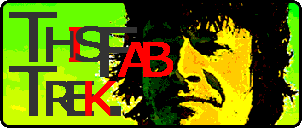


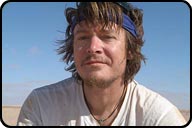
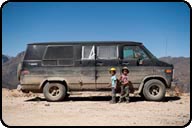


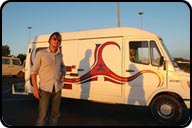
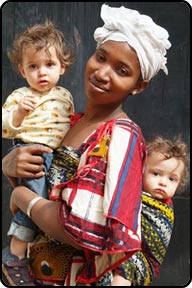
 contains Festival/Fiesta/Art photography.
contains Festival/Fiesta/Art photography.
